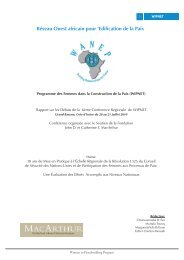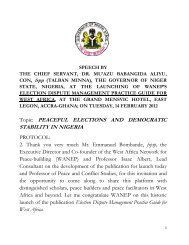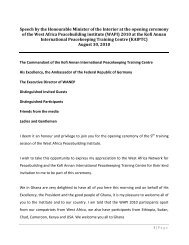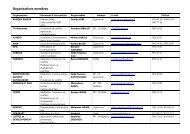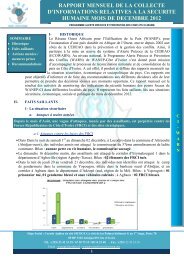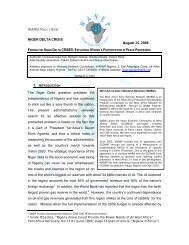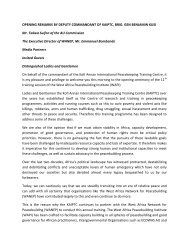DEVELOPMENT AND IMPLEMENTATION of National Action Plans ...
DEVELOPMENT AND IMPLEMENTATION of National Action Plans ...
DEVELOPMENT AND IMPLEMENTATION of National Action Plans ...
You also want an ePaper? Increase the reach of your titles
YUMPU automatically turns print PDFs into web optimized ePapers that Google loves.
Section 4: Monitoring and Evaluation <strong>of</strong> NAPs••Monitoring is a continuous process that aims to provide main stakeholders with regularfeedback and early indications <strong>of</strong> progress or lack <strong>of</strong> it in the achievements <strong>of</strong> intendedresults.••Monitoring tracks the actual performance or situation against what is planned orexpected according to pre-determined standards.••Evaluation is the systematic and objective assessment <strong>of</strong> an on-going or completedproject, programme or policy. The aim <strong>of</strong> evaluation is to determine the relevance andachievement <strong>of</strong> objectives, efficiency, effectiveness, impact and sustainability.••Both M & E utilize data to inform decision-making and to contribute to generating lessonslearnt though they differ in terms <strong>of</strong> when and how <strong>of</strong>ten the activities are carried outand what decisions each informs.••For effective implementation <strong>of</strong> NAPs, it is imperative to develop context specificindicators. In addition, it is necessary to develop a log frame stating the milestonesand indicators <strong>of</strong> progress as well as timeframes (Annex 3) as well as a monitoring andevaluation matrix (Annex 4).••Because <strong>of</strong> the number <strong>of</strong> different groups potentially involved in implementation andsubsequently in M & E, it is essential that a NAP includes clear lines <strong>of</strong> responsibilities anddelineation <strong>of</strong> tasks for each actor involved. M & E allows those who are responsible forprogrammatic activities to track results, inform future planning efforts and judge what isworking/not working and what should be modified.••Evaluation could be internal or external but external evaluation <strong>of</strong> the implementation<strong>of</strong> a NAP is preferred because it can help to challenge implicit assumptions andorganizational norms that have become standard practice, independent <strong>of</strong> politicalinterests or bureaucratic fatigue as well as help to achieve a more objective evaluation <strong>of</strong>programming which can lend the evaluation and the implementation <strong>of</strong> the NAP greatercredibility.••NAPs should be time-bound documents that should be fully revised and a new planshould be developed at the end <strong>of</strong> the set time frame. M & E allows government agenciesto learn from past experiences and adapt to changing circumstances as needed.Who should be involved in M & E <strong>of</strong> NAPs?••Depending on the country context, a variety <strong>of</strong> actors can potentially be involved inM & E <strong>of</strong> NAPs.••These can include government bodies and institutions including the military, members<strong>of</strong> civil society and independent experts or consultants. For this reason, a NAP mustinclude a clear delineation <strong>of</strong> what actors are responsible for the various tasks involved inM & E. This is important so that relevant agencies and individuals can be held accountablefor their part in the implementation process.••However, actors involved in M & E should have the required technical knowledge andcapacity.••Several approaches can be used in the M & E <strong>of</strong> NAPs:»»Establishment <strong>of</strong> an independent M& E Committee made <strong>of</strong> CSOs and other organizations20



![English [266KB] - West Africa Network for Peacebuilding](https://img.yumpu.com/50460007/1/184x260/english-266kb-west-africa-network-for-peacebuilding.jpg?quality=85)



